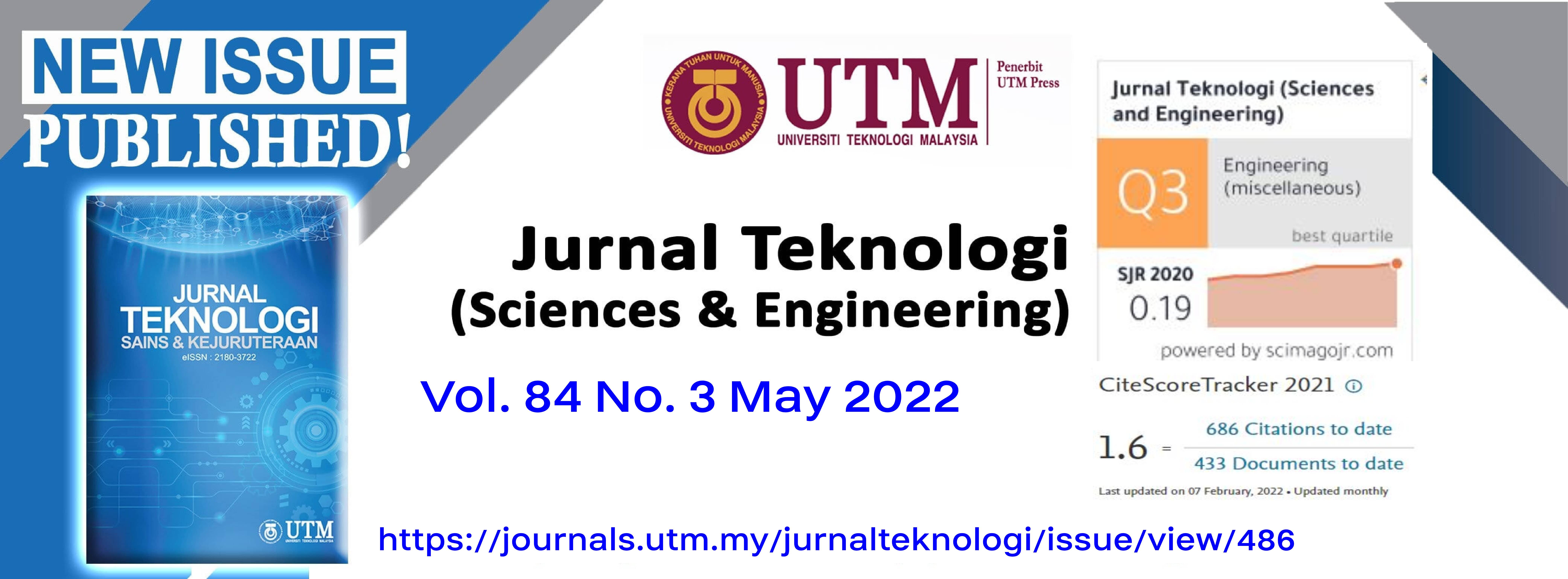CONFIGURATION OF HYBRID FUEL-ELECTRIC AIRCRAFT MODEL BASED ON FULL FLIGHT PATH PERFORMANCE
DOI:
https://doi.org/10.11113/jurnalteknologi.v84.16828Keywords:
Hybrid propulsion, Fuel-Electric propulsion, Hybrid aircraft, Flight performance, Fuel-first strategyAbstract
A new approach to enhance the performance of hybrid fuel-electric aircraft is investigated. This approach adopts Fuel-first strategy (FFS) to increase the effectiveness of electrical propulsion. To illustrate the effectiveness of this method, it is compared to other propulsion types. The FFS is based on starting the electric propulsion only after the aircraft reaches the lowest weight. That is, when fuel is fully consumed. This involves inflight switching of propulsion type, where the first part of the flight is powered by fuel only and the second part is fully-electric. A hybrid version of Piper Cherokee is used to demonstrate the new concept. Modified versions of Breguet equation and Payne range strategy are used to calculate aircraft performance. Adopting FFS resulted in 10.3% fuel saving relative to conventional propulsion as well 4.2% fuel saving relative to parallel hybrid propulsion. The main theme behind this proposal is that by consuming the fuel first, the aircraft becomes lighter sooner, and this enables the batteries to power the aircraft for longer range. Upon comparing the method with other methods in the literature, it was found superior in terms of fuel consumption and performance.
References
Venson, G. G. 2013. Personal Collection for Aircraft Design. Aeronautical Engineering Program. Federal University of Uberlândia. https://repositorio.ufu.br/bitstream/123456789/26592/3/Influ%C3%AAncia Ferrament-asCAD.pdf.
Shahid, S., Minhans, A., Puan, O. C. 2014. Assessment of Greenhouse Gas Emission Reduction Measures in Transportation Sector of Malaysia. Jurnal Teknologi (Science and Engineering). 70(4): 1-8. DOI: https://doi.org/10.11113/jt.v70.3481.
Voskuijl, M., Bogaert, J. V., Rao, A. G. 2018. Analysis and Design of Hybrid Electric Regional Turboprop Aircraft. CEAS Aeronaut J. 9: 15-25. DOI: https://doi.org/10.1007/s13272-017-0272-1.
Mengistu, I. H. 2012. Small Internal Combustion Engine Testing for a Hybrid-electric Remotely-piloted Aircraft. Air Force Institute of Technology. Wright-Patterson Air Force Base. Ohio. https://www.semanticscholar.org/paper/Small-Internal-Combustion-Engine-Testing-for-a-Mengistu/ 425f819360423460b64ebd816e396af5b45f0708.
Hepperle, M. 2012. Electric Flight-potential and Limitations. German Aerospace Center. Institute of Aerodynamics and Flow Technology. Braunschweig, Germany.
http://www.cso.nato.int/ Meetings.aspx?RestrictPanel=1.
Miller, M. J. 2004. Propulsion Systems for Hybrid Vehicles. The Institution of Electrical Engineers. London. DOI: 10.1049/PBPO045E.
Friedrich, C. and Robertson P. A. 2014. Design of a Hybrid-electric Propulsion System for Light Aircraft. 14th AIAA Aviat. Technol., Integration, and Operations Conf. Atlanta, Georgia. DOI: https://doi.org/ 10.2514/6.2014-3008.
Friedrich, C., Robertson, P. A. 2015. Hybrid-electric Propulsion for Aircraft. Journal of Aircraft. 52(1): 176-189. DOI: https://doi.org/10.2514/1.C032660.
Katrašnik, T., Tranc, F., Rodman, O. S. 2007. Analysis of the Energy Conversion Efficiency in Parallel and Series Hybrid Powertrains. IEEE Transactions on Vehicular Technology. 56(6): 3649-3659. DOI:10.1109/ TVT.2007.901033.
Sliwinski, J., Gardi, A., Marino, M., Sabatini, R. 2017. Hybrid-Electric Propulsion Integration in Unmanned Aircraft. Energy. 140: 1407-1416. DOI: 10.1016/j.energy.2017.05.183.
Bravo, G. M., Praliyev, N., Veress, A. 2021. Performance Analysis of Hybrid Electric and Distributed Propulsion System Applied on a Light Aircraft. Energy. 214. DOI: https://doi.org/10.1016/j.energy.2020. 118823.
Rohacs, J. and Rohacs, D. 2020. Energy Coefficients for Comparison of Aircraft Supported by Different Propulsion Systems. Energy. 191. DOI: https://doi.org/10.1016/j.energy.2019.116391.
Baharozu, E., Soykan, G., Ozerdem, M. B. 2017. Future Aircraft Concept in Terms of Energy Efficiency and Environmental Factors. Energy. 140(2): 1368-1377. DOI: https://doi.org/10.1016/j.energy.2017.09.007.
Brelje, B. J. and Martins, J. R. 2019. Electric, Hybrid, and Turboelectric Fixed-wing Aircraft: A Review of Concepts, Models, and Design Approaches. Progress in Aerospace Sciences. 104: 1-19. DOI: https://doi.org/ 10.1016/j.paerosci.2018.06.004.
Pornet, C. and Isikveren, A. T. 2015. Conceptual Design of Hybrid-electric Transport Aircraft. Progress in Aerospace Sciences. 79: 114-135. DOI: https://doi.org/10.1016/j.paerosci.2015.09.002.
Hung, J. Y., Gonzalez, L. F. 2012. On Parallel Hybrid-electric Propulsion System for Unmanned Aerial Vehicles. Progress in Aerospace Sciences. 51: 1-17. DOI: https://doi.org/10.1016/j.paerosci.2011.12.001.
Ang, A. X., Rao, A. G., Kanakis, T., and Lammen, W. 2019. Performance Analysis of an Electrically Assisted Propulsion System for a Short Range Civil Aircraft. Proc IMechE Part G: J Aerospace Engineering. 233(4): 1490-1502. DOI: https://doi.org/10.1177/0954410017754146.
Hoelzen, J., Liu, Y., Bensmann, B., Winnefeld, C., Elham, A., Friedrichs, J., and Rauschenbach, R. H. 2018. Conceptual Design of Operation Strategies for Hybrid Electric Aircraft. Energies. 11: 217. DOI: https://doi.org/ 10.3390/en11010217.
James, W. and O’Dell, P. 2005. Rolls Royce, Derated Climb Performance in Large Civil Aircraft. The 2005 Boeing Performance and Flight Operations Engineering Conference.
https://www.theairlinepilots.com/ forumarchive/quickref/deratedclimbperformance.pdf.
Donateo, T. and Totaro, R. 2018. Hybridization of Training Aircraft with Real World Flight Profiles. Aircraft Engineering and Aerospace Technology. DOI: https://doi.org/10.1108/AEAT-01-2018-0036.
Singh, V. 2017. Fuel Consumption Minimization of Transport Aircraft Using Real-coded Genetic Algorithm. Proceedings of the Institution of Mechanical Engineers Part G Journal of Aerospace Engineering. 232(7): 1-19. DOI: 10.1177/0954410017705899.
Al-Habahbeh, O. M., Al-Khalaileh, R. Y., Daoud, M. M., Al-Sheyyab, Y. I., and Al-Slihat, R. D. 2020. Assessment of Hybrid Airplane Configurations Based on In-flight Performance. Test Engineering & Management: 13208-13214. https://testmagzine.biz/index.php/testmagzine/article/view/2953.
Johansson, E. and Unell, F. 2014. Flight Testing of the Piper PA-28 Cherokee Archer II Aircraft. https://www.diva-portal.org/smash/get/diva2:752136/FULLTEXT01. pdf.
Quest for Performance: The Evolution of Modern Aircraft, Part I: The age of propellers. 2020. NASA History Division. 1945-80. https://history.nasa.gov/SP-468/ch6-3.htm6.
Cherokee PA-28-180 Technical Specifications. 2020. Globalair. Louisville, KY. https://www.globalair.com/aircraft-for-sale/Specifications?specid=101.
Hemi, H., Sirdi, N., and Naamane, A. 2019. A New Proposed Shepherd Model of a li-ion Open Circuit Battery based on Data Fitting. IMAACA 2019. Lisbon, Portugal. https://hal.archives-ouvertes.fr/hal-02471659.
Downloads
Published
Issue
Section
License
Copyright of articles that appear in Jurnal Teknologi belongs exclusively to Penerbit Universiti Teknologi Malaysia (Penerbit UTM Press). This copyright covers the rights to reproduce the article, including reprints, electronic reproductions, or any other reproductions of similar nature.
















